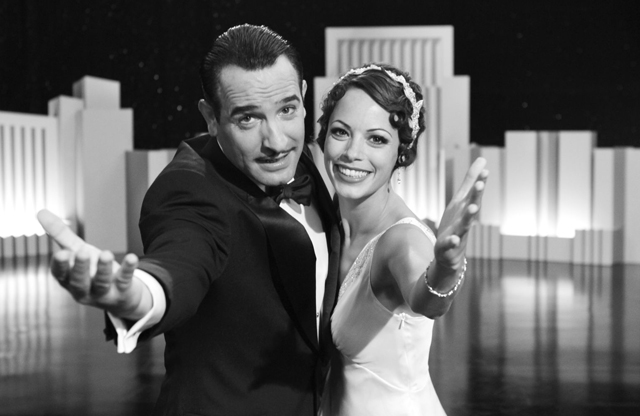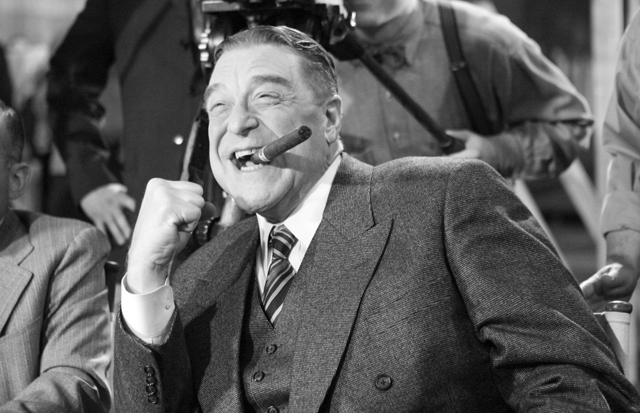CHICAGO – Patrick McDonald of HollywoodChicago.com appears on “The Morning Mess” with Dan Baker on WBGR-FM (Monroe, Wisconsin) on March 21st, 2024, reviewing the new streaming series “Manhunt” – based on the bestseller by James L. Swanson – currently streaming on Apple TV+.
Interview: Director Michel Hazanavicius Becomes ‘The Artist’
CHICAGO – The sheer craft of the actor’s expression is what drove the early “silent” film industry, before syncing up the “talking.” Director Michel Hazanavicius has a new film opening called “The Artist,” in which he explores the expression of early moviemaking, during the era of its transition to talking, and it is rendered as a silent film.
“The Artist” is beautiful, and essential viewing as a glimpse into that passionate era of moviemaking, approximately from 1927 to 1932. Stylistically, it borrows from the canon of that era, where the flappers and film studios joined forces creatively to produce what was best described by by Norma Desmond (Gloria Swanson) in “Sunset Blvd,” – “We didn’t need dialogue, we had faces!”
 Photo credit: The Weinstein Company |
Director Hazanavicius first made his mark brilliantly aping another era of filmmaking, with his James Bond spoof, “OSS 117: Cairo, Nest of Spies.” That film is lushly shot in the faded color style of the late 1950s, and the film stars the same actors, Jean Dujardin and Bérénice Bejo, who are the main characters in “The Artist.” After shooting an OSS sequel, Hazanavicius came up with the idea for his silent-film-era love letter, and the rest is cinema history.
Michel Hazanavicius was recently in Chicago promoting the film, and HollywoodChicago.com got to interview this provocative artist, on the eve of his greatest film triumph so far.
HollywoodChicago: When did the idea for ‘The Artist’ first appear, was it when you were watching a particular silent film or was it based for your love of the era? And what is the significance of the title?
Michel Hazanavicius: It is very hard to figure out when it started. What I know is that for a long time, it was a fantasy, it was like a dream. I had to convince myself first about it. I made two films with Jean [Dujardin] and one with Bérénice [Bejo], and I married Bérénice. And the two films that I made with Jean were so different, that it kind of gave me the power for what I wanted to do with this. It also gave me the self confidence to say to myself maybe I’m able to do it. And maybe I’m able to find some money and convince people to join me in this adventure.
When it became a real project is when I met the producer, Thomas Langmann. I’ve seen other producers, and when I told them about the silent movie idea, they were already against it. When I met Langmann, he wanted me to do a French superhero movie. I said I’d do it, but it would be silent and in black and white. He was surprised by that. So I pitched him two sequences of ‘The Artist,’ and I could see by his eyes that he really wanted to do the movie. He paid me for the writing, but when I started I couldn’t guarantee him the finished script. I wrote the script and realized it was doable.
Langmann thought of the title. My title was ‘Beauty Spot.’ Because that was between the two main characters, that tiny beauty mark. It wasn’t hooking enough. He proposed me ‘The Artist,’ and I tried it out, and everyone thought it was a good title. The title doesn’t have to convince me, it has to convince other people.
HollywoodChicago: What specific films did you assign Jean Dujardin and Bérénice Bejo to watch, in studying the character traits that you wanted them to express?
Hazanavicius: Bérénice, since she is my wife, really did the immersion in the project with me. I watched over a hundred films, she probably saw eighty. For Jean, it was a little bit different, he was working and he’s not my wife. [laughs] When he read the script, he was a little bit afraid because he didn’t have the culture of the silent era. He didn’t know how to tell that story through character.
I showed him ‘Sunrise’ and ‘City Girl,’ the two F.W. Murnau American films. I showed him King Vidor’s ‘The Crowd.’ I asked him to re-watch Chaplin’s ‘City Lights’ and ‘Modern Times.’ He has the expression of the acting, and I wanted not to ape the acting of the 1920s, but for it to flow naturally.
 Photo credit: The Weinstein Company |
HollywoodChicago: You make many references to other films in ‘The Artist.’ Which specific tribute was your favorite and why? And which of the directors of the era do you most relate to, as far as creating a style for the film?
Hazanavicius: I would say with the directors of that era it would be Murnau, Josef von Sternberg and King Vidor. In the film, you recognize ‘Citizen Kane,’ ‘Sunset Blvd.’ and ‘Singin’ In the Rain,’ because that’s what I wrote into my story. After I told everyone, okay, you did your homework and research, now it is time to tell my story. We don’t care about references, we don’t care about nothing. I felt like someone at the entrance of a nightclub, determining who and what goes in and out. For example, I wanted to do the ‘Citizen Kane’ breakfast sequence, and I questioned whether I would do it or not. But in the end I wanted to give the audience the look and signal of a classic Hollywood era.
HollywoodChicago: As ‘The Artist’ points out, so much of fame and notoriety in Hollywood has to do with the right place and time. What was your ‘right place and right time’ moment on the way up the ladder?
Hazanavicius: I worked at Canal+ TV channel in France. When I was a kid, we only had two channels. These channels only broadcast in the afternoon and evening. Then eventually there was a third, and finally in 1984 a fourth, which was Canal+. They started doing programming and in 1988 it became very special. It was insolent, free and very new. It was the right place to be. I started working there in 1988, with a great group of comedians who did a show similar to Saturday Night Live. People really loved it, it was new, political and funny. This is where I learned how to work, and more importantly it gave me an absolute sense of freedom, knowing what I do means something. I became my own censor. You had to be a bad kid and an adult, to stay creative.
Photo credit: Patrick McDonald for HollywoodChicago.com |
HollywoodChicago: There is a twinge of geographic politics in the OSS series, sort of Pink Panther meets Dr. Strangelove. What fascinates you about both the power players of the era and the prejudices and ignorance that came out of that power?
Hazanavicius: This character [Hubert de la Bath, OSS 117] is so racist, arrogant, homophobic and anti-Semitic. By putting him in a period setting I could get away with it. You don’t see yourself in that character, it’s another era. He doesn’t know that he can’t be like that, because it’s in the 1950s. That was the reason for the era, to make those jokes acceptable. The movies I reference are so elegant, chic and nice, that it creates a good balance with the stupidity. People need justification.
HollywoodChicago: Finally, in the parallel cinema universe offered by ‘The Artist,’ do the main characters George and Peppy become legendary stars, or do they fade into oblivion in the current era?
Hazanavicius: I don’t know what will happen. It was so much work to take care of what’s in the film, and I am the boss of what was inside that the film, that I don’t know the outside. It’s not my department. [laughs]
 | By PATRICK McDONALD |


